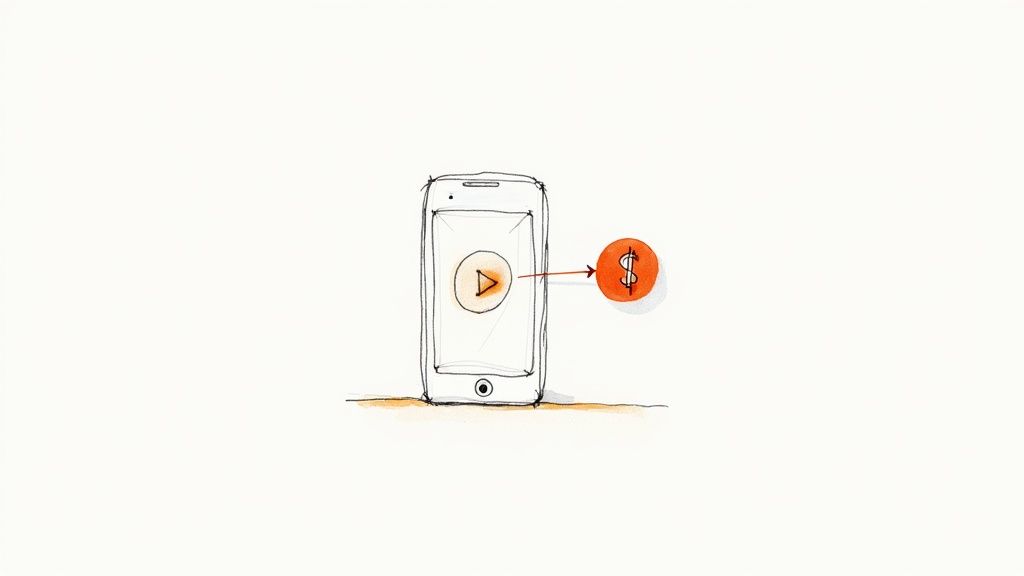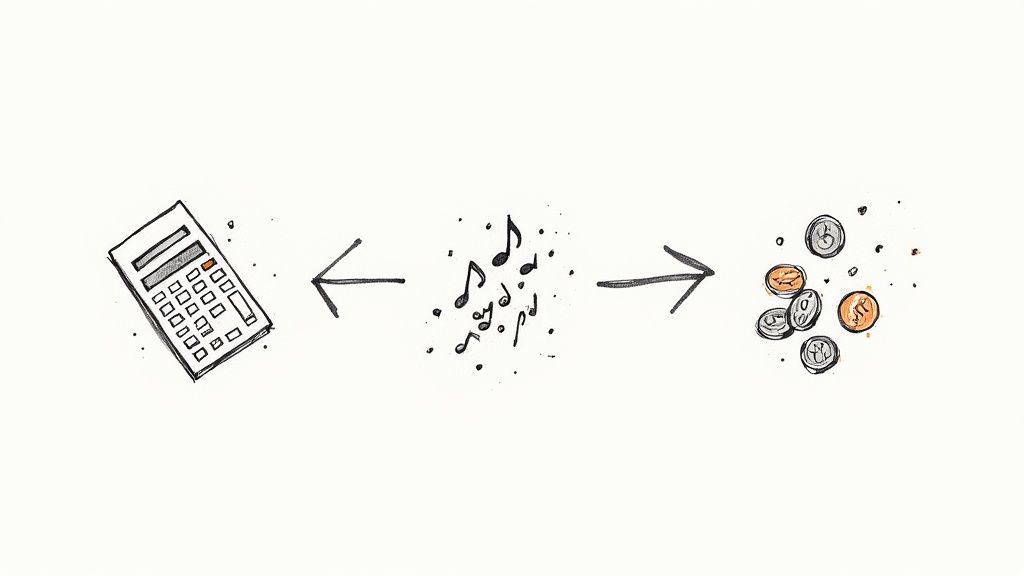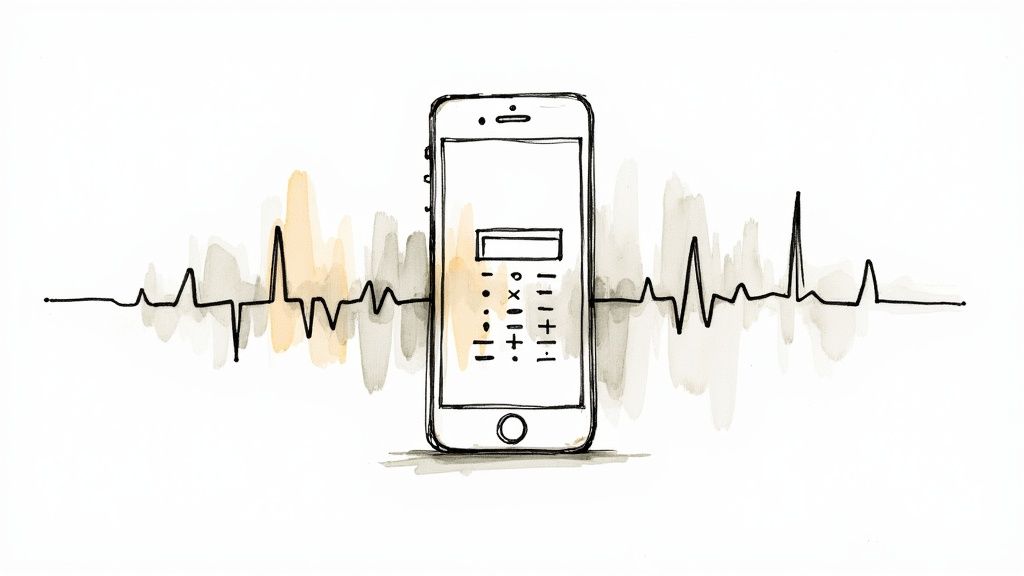How to Calculate Spotify Royalties Accurately
- jañp jalo
- Jun 28
- 11 min read
If you're an artist trying to figure out what you've earned from Spotify, I have to be upfront with you: it's not as simple as plugging one number into a calculator. The biggest myth out there is that Spotify pays a fixed rate for every stream. The reality is that your earnings come from a share of Spotify's total revenue pool, not a flat fee.
This is what the industry calls a "pro-rata" system, and getting a handle on it is the first real step toward understanding your music's financial performance.
The Real Mechanics of Spotify Royalties

Before you can get anywhere near an accurate earnings estimate, you have to let go of the idea of a single per-stream payout. Your final payment is a slice of a much bigger pie—one that’s baked fresh every single month.
The global music streaming market runs on this pro-rata model. Essentially, Spotify pools all the subscription fees and ad revenue for a given month, then divides that money among artists and rights holders based on their share of the total streams. It’s a massive pie, too. Spotify has paid out over $60 billion in royalties since its launch, a figure that underscores just how central it is to the modern music economy.
With the industry expected to hit one billion paying subscribers soon, that revenue pool is only going to expand. If you want to dive deeper into these trends, Spotify's own Loud & Clear report offers some great insights.
Key Factors That Influence Your Royalty Rate
So, what determines the size of your slice? It boils down to a few critical variables that make every stream's value different. This is precisely why a single "per-stream rate" is so misleading—not all streams are created equal.
Key Takeaway: Stop thinking in terms of a fixed per-stream payout. Instead, focus on your share of the total monthly revenue pool, which is influenced by who is listening and where they are located.
To get a clearer picture, let's look at the main factors that directly impact your earnings.
Key Factors That Influence Your Royalty Rate
These are the core variables that determine the actual value of each stream you get. Understanding them helps explain why your earnings can fluctuate so much from month to month.
Factor | What It Means | Impact on Your Earnings |
|---|---|---|
Listener's Subscription Type | Whether the listener is a paid Spotify Premium subscriber or using the free, ad-supported version. | A stream from a Premium user is worth significantly more because they contribute directly to the monthly revenue pool. |
Listener's Geographic Location | The country where your listener is streaming from. | Subscription prices vary worldwide. A stream from a country like Switzerland or Norway pays more than one from a region with lower subscription costs. |
Total Monthly Streams | The total number of streams across the entire platform in a given month. | Your stream count is measured against the platform's total. A month with higher overall streaming activity can slightly dilute the value of each individual stream. |
As you can see, your final payout is a blend of all these elements. It’s a dynamic calculation, not a static one.
How Spotify's Royalty Formula Really Works
If you've ever heard someone say you earn a fixed amount every time your song is played on Spotify, you've heard a myth. The reality is a bit more complex, but it’s crucial for any artist to understand. It's not about a simple "price-per-stream" but rather your slice of a much larger, constantly changing pie.
This is the basic flow, from a listener hitting play to the money eventually reaching the rights-holders.

As the graphic shows, Spotify first gathers all the money from listener subscriptions and ad revenue for a given month. Only then does it get divided up among the artists.
The Royalty Pool and Your "Stream Share"
So, how does that division actually happen? It starts with what's called the Net Revenue Pool. This is the total cash Spotify brings in from a specific country in a single month (think all Premium fees and ad money in the U.S. for April), after they’ve taken out their cut.
From there, it’s all about your Stream Share. This isn't just your raw stream count; it's the percentage of total streams you own in that market. The formula looks like this:
(Your Total Streams in a Market) / (All Streams in That Market for the Month) = Your Stream Share
That percentage is everything. It's your official claim on that month's revenue pool.
Putting It All Together
Once Spotify knows the size of the revenue pool and your share of the streams, the final calculation is straightforward.
Formula: Net Revenue Pool x Your Stream Share = Your Gross Royalty Payout
Let's run a quick, hypothetical scenario. Imagine Spotify's Net Revenue Pool for the U.S. in April was $50,000,000. If all your songs combined accounted for 0.0001% of the total streams in the U.S. that month, your gross payout would be $5,000.
While this means the effective "per-stream" rate is always shifting, it does tend to land in a general range. From what I've seen, most artists can expect to earn between $0.003 and $0.005 per stream. The final number depends heavily on factors like where your listeners are located and whether they're on a Premium or ad-supported plan.
This calculation reflects the widely accepted 70/30 industry standard, where roughly 70% of Spotify's total earnings are paid out to rights-holders. If you want to dig deeper into these averages, Ditto Music's blog has some great information on the topic.
Why Not All Music Streams Are Created Equal
Ever look at your royalty statements and wonder why the per-stream rate seems to jump all over the place month to month? It’s not just you. The simple truth is that not every single stream holds the same financial value. Who is listening and where they are in the world makes all the difference.
Think of it this way. A listener on a Spotify Premium plan is directly feeding the royalty pool with their subscription fee. In contrast, a stream from a free user is only worth whatever ad revenue was generated during their listening session. This is the biggest reason why 10,000 streams from paid subscribers will always put more money in your pocket than the same number of streams from the free tier.
Key Insight: To really understand your earnings, you have to look beyond the total stream count and focus on the quality of those streams. A smaller, dedicated fanbase of paid subscribers can often be more valuable than a massive audience of casual, free-tier listeners.
The Impact of Geography and Subscription Type
Beyond the premium vs. free split, where your listeners live plays a huge part in what you earn. Spotify adjusts its subscription prices based on local economies, so the value of a stream changes from country to country.
A stream from a listener in a country with a high subscription cost, like Switzerland or Norway, adds more money to that country's royalty pool.
On the other hand, a stream from a region with lower subscription prices contributes a smaller amount to its own pool.
This geographical puzzle piece is especially important for artists building an international audience. In fact, Spotify recently revealed that for many artists, more than 75% of their music royalties came from listeners outside their home country. This really shows how a global fanbase directly complicates any simple earnings calculation. You can dive deeper into these global payout trends on Spotify's newsroom.
It gets even more granular. Even different paid plans aren't equal. Streams from discounted Family or Student plans, for instance, generate less revenue than a stream from someone on a full-priced Individual plan. Each one of these factors is another small variable that goes into that final, complex number on your royalty statement.
Where to Find the Numbers for an Accurate Estimate
To get a real sense of your Spotify earnings, you'll need to do a little digging for the right data. It's all about matching what Spotify tells you with what your distributor pays you.
First, you’ll want to head straight to your Spotify for Artists dashboard. This is your home base for all things stream-related and where you'll find the raw numbers. Don't just look at the total stream count; the real magic is in the details.
Inside your dashboard, click over to the "Audience" tab. This is where you can break down your streams by specific timeframes and, crucially, by country. Royalties are paid out differently everywhere, so knowing that 20,000 of your streams came from the US and 5,000 from Brazil is key.
This geographic breakdown is the first piece of the puzzle.

Seeing where your listeners are helps you focus your efforts. If a country is blowing up for you, that's where you'll want to zero in on the financial data.
Digging Into Your Distributor’s Royalty Reports
The second piece of the puzzle comes from your music distributor—think DistroKid, TuneCore, CD Baby, or whoever gets your music onto Spotify. This is where you find the money side of the equation.
Log into your distributor's portal and look for a section labeled something like "Bank," "Earnings," or "Money." You're searching for their detailed royalty reports. These are often downloadable as or files.
A quick heads-up: These files are usually massive spreadsheets. It might look intimidating, but this is where the gold is. Inside, you’ll find the exact payout for a certain number of streams from a specific country, right down to the subscription tier (Premium vs. Free). This is the only place to find your actual per-stream rate for a given period.
Matching the stream counts from Spotify for Artists with the payout data from your distributor is how you get the full, accurate picture.
I know, it can feel like a lot of manual spreadsheet work. That's why many artists use tools to simplify things. If you want a solid projection without getting lost in the numbers, our Spotify royalties calculator can help you connect the dots and make sense of it all.
Of course. Here is the rewritten section, designed to sound completely human-written and natural.
A Smarter Shortcut: Using Online Royalty Calculators
Let's be honest, not everyone wants to get lost in a spreadsheet trying to figure out potential earnings. If manual number-crunching isn't your thing, there are some fantastic online calculators that do the heavy lifting for you. While your official distributor statement is always the final word, a good Spotify royalties calculator can give you a solid ballpark estimate in seconds.
I've pointed a lot of artists toward tools like the one from artist.tools or SoundCampaign. They're usually incredibly straightforward. You just plug in your total stream count, and the calculator applies an estimated pay-per-stream rate to spit out a number. It’s a super useful way to get a quick financial snapshot of your music's performance.
Here’s a look at the artist.tools calculator, which I particularly like for its flexibility.
See that slider? That's the key. It lets you adjust the estimated rate. If you know from your past statements that your rate tends to be around $0.0035, you can set it there for a much more realistic projection. This kind of personalization is crucial because, as we've covered, no two artists' per-stream rates are identical.
Finding the Right Balance Between Speed and Precision
So, what's the catch? Well, it's a classic trade-off between convenience and perfect accuracy. These tools are built for speed, which makes them incredibly valuable for specific situations.
I find they're perfect for things like:
Quick "what if" scenarios: Your new single is getting traction on a big playlist? A calculator can give you a fast projection of what that might mean for your wallet.
Setting clear goals: You can work backward to figure out how many streams you might need to hit a certain income target for a tour or new gear.
A-B testing your tracks: Curious about the potential earnings of one song versus another? A quick calculation can give you a directional idea.
Just remember, these calculators rely on averages. They have no way of knowing the exact mix of countries or subscription tiers your listeners came from this month. Think of the number they give you as a well-informed estimate, not a guaranteed deposit.
My Two Cents: Use online royalty calculators for quick insights and financial forecasting. They’re an excellent planning tool. But when it's time to get down to business, always, always treat your official distributor reports as the source of truth. Those statements are what determine what actually hits your bank account.
Where Your Royalty Money Really Goes
So you've run the numbers and have a "gross" figure for your Spotify earnings. That’s a great start, but it's not the amount that will actually hit your bank account. The journey from Spotify's payout to your pocket has a few stops, and at each one, different partners take their share. Getting a handle on this money trail is the key to understanding the difference between a royalty calculator's estimate and your real-world earnings.
Your first stop is almost always your distributor. Think of services like DistroKid or TuneCore. They’re the essential bridge that gets your music onto streaming platforms and collects the initial payment for you. For this service, they’ll typically take a commission, usually somewhere between 8% and 20%, or they might charge a flat annual fee.
After the distributor takes their piece, the remaining money is split based on the two fundamental types of what music royalties are: one for the master recording and one for the song itself (the composition).
The Major Splits and Deductions
If you’re signed to a record label, this is where they step in. They’ll take their contractually agreed-upon percentage from the recording royalties. How big that slice is can vary wildly depending on the specifics of your deal.
Next up, you have the publishing royalties. A publisher's job is to chase down the money owed for the underlying composition—the melody and lyrics. They’ll take their cut, often around 15% of the publishing share, before sending the rest to the songwriters.
The Bottom Line: Your final payout is what's left after your distributor, publisher, co-writers, producers, and label (if you have one) all take their cuts. Every artist's situation is unique, so your net percentage is entirely specific to your career setup.
It's a system unique to the music industry, but it can be helpful to look at how other creators get paid. Seeing how much an influencer can earn provides some interesting context. After all, artists are influencers, and understanding the broader creator economy helps put these deductions into perspective.
Finally, if you worked with co-writers or had a producer who gets a percentage, their shares are calculated from the remaining pots of money. What’s left after all that is your final net income.
Common Questions About Spotify Royalties

Even with all the data and formulas at your fingertips, you're bound to have some lingering questions. That's perfectly normal. From my experience, a few specific questions pop up again and again when artists try to pin down their Spotify earnings.
Let's clear up some of the most common points of confusion. Getting these details right will help you set realistic expectations and better understand the money side of your music.
How Often Does Spotify Pay Out Royalties?
This is probably the number one question I get. While Spotify pays out to rights-holders (your distributor, label, etc.) every month like clockwork, that doesn't mean you see the cash right away.
Think of your distributor as the crucial middleman. Once they get the money from Spotify, they have their own accounting to do. For most distributors, it takes another 1 to 3 months to process everything and deposit the royalties into your account. The best advice is to check your specific distributor's payment policy—they'll lay out their exact timeline for you.
Why Don't My Estimated Royalties Match My Payout?
It's a moment of frustration for almost every artist. You meticulously calculate an estimate, but the final payout statement tells a different story. This is not only common; it's expected.
The gross royalty figure you calculate is just the starting point—it's always before anyone takes their piece of the pie. Your distributor, publisher, any co-writers, and your label all get their contractually obligated shares first. On top of that, every online calculator uses an average per-stream rate. Your actual rate is a moving target, changing every single month based on Spotify's total revenue and stream count.
The Key Takeaway: The only number that truly matters is on your official distributor statement. That document is the source of truth, reflecting the precise, variable data and all the deductions for that specific pay period.
Do Saves or Playlist Adds Generate Royalties?
The short answer is no. A listener saving your track or adding it to a playlist doesn't directly earn you a cent. You only get paid when someone streams your song for at least 30 seconds.
But don't discount these actions—they are incredibly valuable. Saves and playlist adds are powerful signals to Spotify's algorithm. They scream, "People love this song!" which massively boosts your chances of landing on influential algorithmic playlists like Discover Weekly and Radio. Those placements are what drive the streams that do generate royalties. So, think of saves and adds as the assist that sets up the goal.
For a deeper dive into what artists are actually earning, check out our guide on how much Spotify artists make for some real-world examples.
Ready to move from guesswork to a clearer financial picture? The artist.tools Spotify Royalties Calculator gives you a quick, flexible way to estimate your earnings and start planning your next career move. Stop guessing and start strategizing at https://artist.tools.
Comments